Massachusetts is located in the northern part of the United States, bordered by Rhode Island, New Hampshire, and Vermont to the north, Connecticut to the south, and New York to the west. It has three major mountain ranges: the Berkshire Mountains in western Massachusetts, the Taconic Mountains in central-western Massachusetts, and the Green Mountains that extend from northwestern Massachusetts into southern Vermont. The state also includes several inland lakes, such as Quabbin Reservoir, Wachusett Reservoir, Long Pond, and Lake Chaubunagungamaug. Within this beautiful landscape, there are also many beautiful trees native to Massachusetts! Let’s take a closer look at this beautiful state, and what it has to offer.
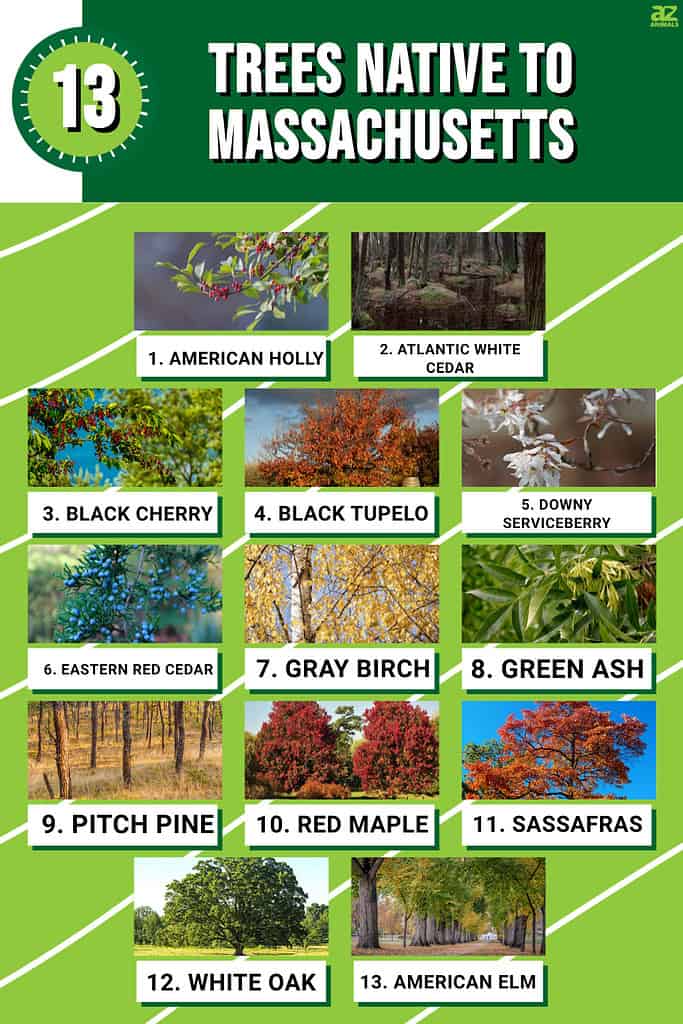
Geography and Climate
The climate of Massachusetts is generally humid continental with mild summers and cold winters. In summer months, temperatures can range from 40°F up to 90°F. Winter temperatures often dip below 0°F. Snowfall totals vary significantly throughout the state due to its topography, with higher elevations receiving more snow than lower-lying areas. Precipitation levels are consistent year-round, ranging anywhere between 30 and 50 inches.
Animals
The fauna of Massachusetts is incredibly diverse, with more than 200 species of mammals, birds, reptiles, and amphibians. Among these are the white-tailed deer, coyote, red fox, and bobcat. There is also a variety of waterfowl, such as ducks, geese, and swans. Massachusetts also has plenty of invertebrates, such as butterflies, moths, and grasshoppers, that live in its forests and wetlands.
Additionally, there are more than 50 species of fish native to its rivers and streams, including salmonids like trout and bass. With so much biodiversity, it’s clear why Massachusetts is considered one of America’s most ecologically diverse states!
Plants
Massachusetts is home to a wide variety of native trees, including maple, oak, birch, and pine. These species are found throughout the state in various habitats ranging from woodlands and wetlands to prairies and urban areas. Each tree species has its own unique characteristics that provide beauty as well as many benefits to our environment, such as providing food sources for wildlife or helping to reduce air pollution. Additionally, many of these native trees have inspired local folklore stories that further demonstrate their cultural importance in Massachusetts. Below are a few of our favorite trees that are native to Massachusetts.
1. American Holly (Ilex opaca)
The long-lived, broad-leaved, evergreen American holly tree grows to 25 to 60 feet tall and provides good cover and nesting sites for birds. It has dark green leaves, stiff horizontal branches, and bright red berries that ripen in October and last through the winter. These berries and evergreen leaves make this tree a great choice for winter interest. They are often used for wreaths, cuttings, and other ornamental purposes.
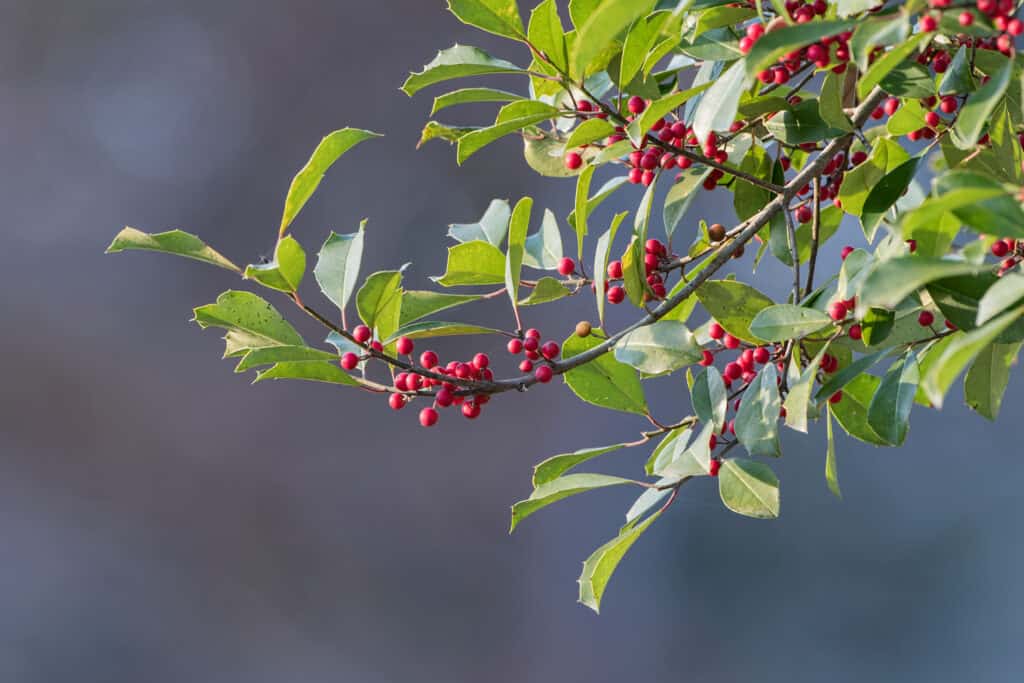
American holly is a popular plant during the Christmas holiday.
©Bonnie Taylor Barry/Shutterstock.com
2. Atlantic White Cedar (Chamaecyparis thyoides)
The Atlantic white cedar is an evergreen tree native to Massachusetts that grows up to 75 feet high. It has short branches and blue-green leaves that spread out in a fan-like appearance. The brown cones contain winged seeds and are popular with local wildlife, who survive during winter by munching on them. The tree usually grows in dense, solid stands in wet areas.
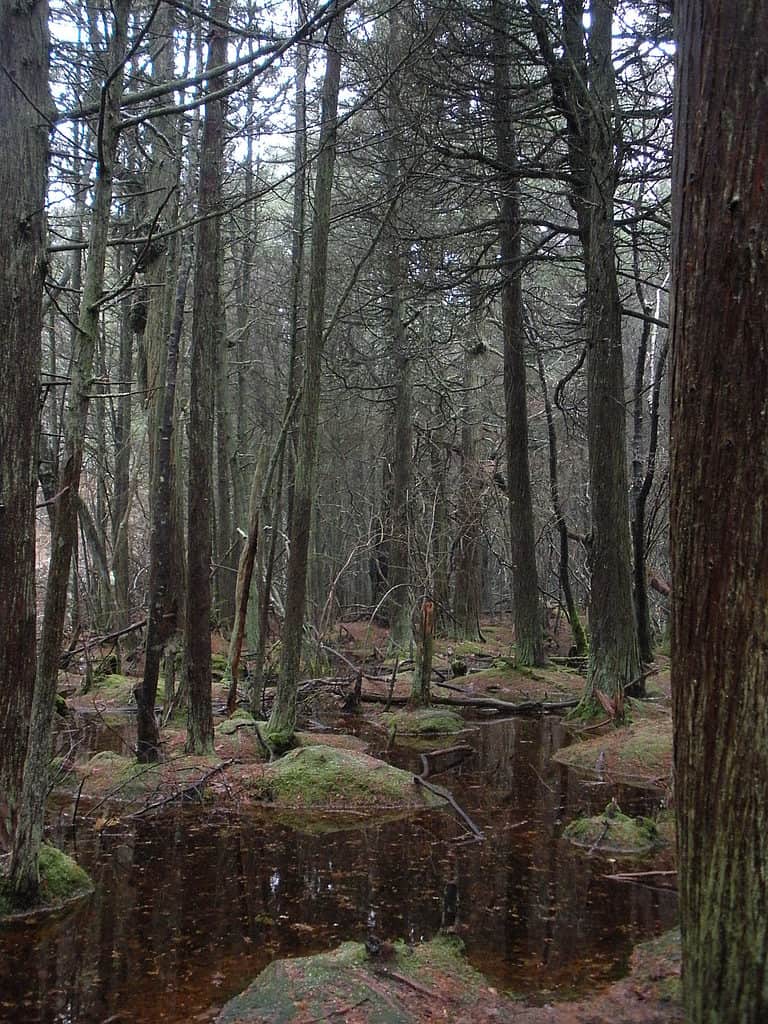
Atlantic white cedar trees prefer wetland habitats.
©iStock.com/indigojt
3. Black Cherry (Prunus serotina)
Black cherry is a deciduous tree native to Massachusetts that grows quickly, reaching up to 90 feet tall. In the spring, it produces fragrant white flowers followed by berry-like fruits. Black cherry is popular with furniture and cabinet makers, and the fruits are crucial food for numerous bird species and mammals.
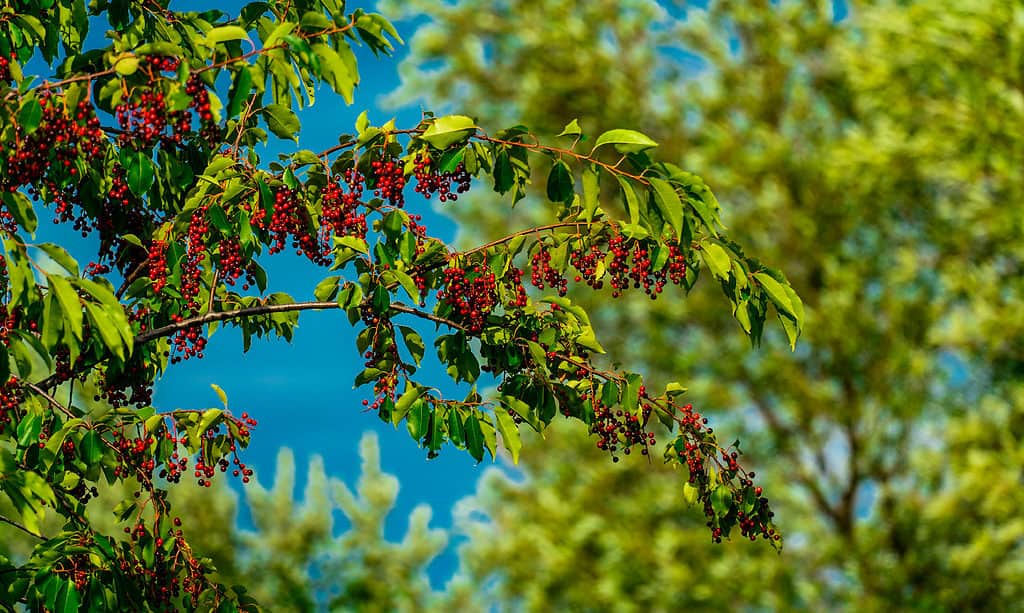
Black cherry trees are also called mountain black cherry trees, rum cherry trees, and wild black cherry trees.
©iStock.com/TeleMakro Fotografie (Ina Hensel)
4. Black Tupelo (Nyssa sylvatica)
The black tupelo tree is a native species to Massachusetts that is perfect for areas of your yard that experience periodic flooding. This tree grows to be about 30 to 60 feet tall, with horizontal branches and a conical or flat-topped crown. The black tupelo is also a rich source of nectar for bees, pollinating insects, and many species of birds.
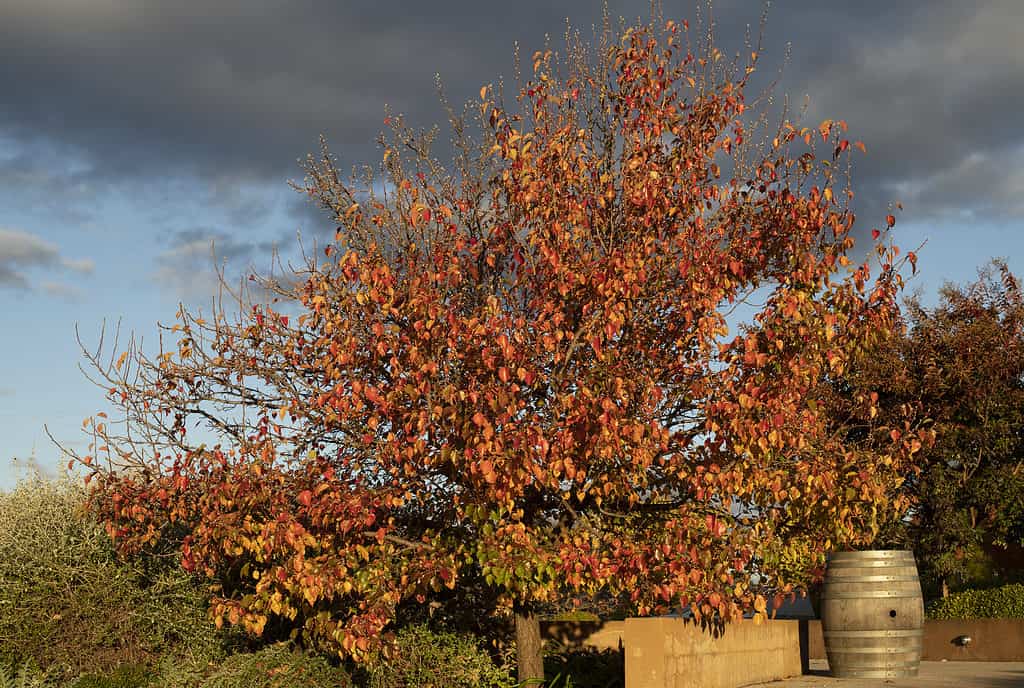
Black tupelo trees transform in the fall into bright colors including yellow, bright red, orange, and purple.
©iStock.com/A-Shot-of-Bliss
5. Downy Serviceberry (Amelanchier arborea)
Downy serviceberry is a deciduous tree or shrub native to Massachusetts that reaches between 12 to 25 feet. The leaves emerge as a soft gray and turn darker green with age. The fall colors are a gorgeous blend of red, orange, and gold. White flowers grow at the very tips of the branch before the leaves, and the fruits are sweet and tart. As you can imagine, many animals and birds find the fruits delicious!
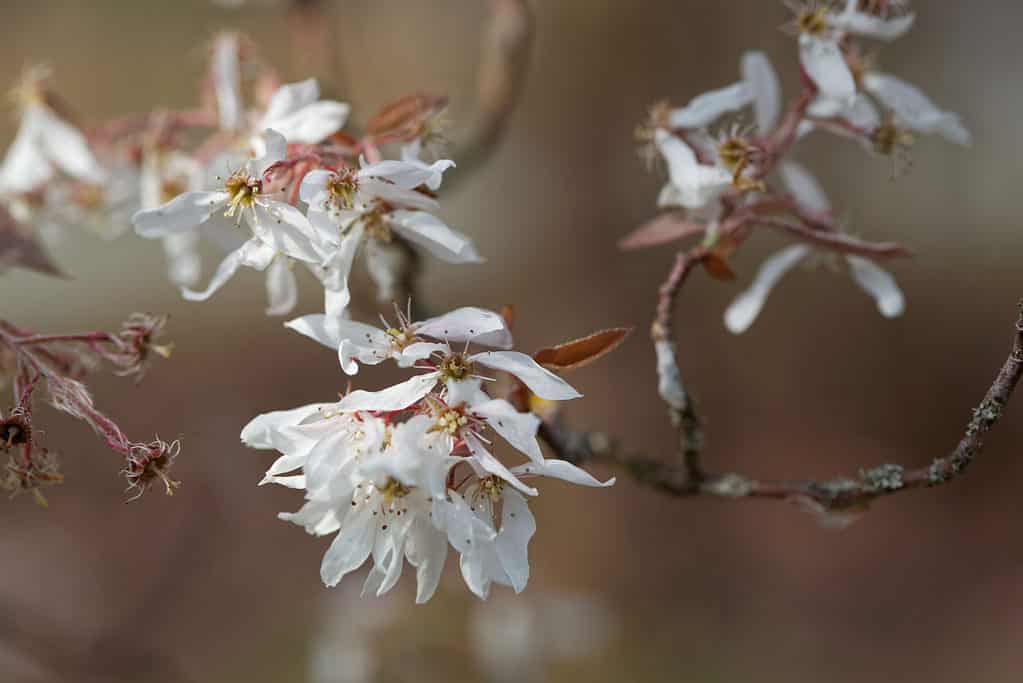
Downy serviceberry fruits are reddish-purple, have an apple-like shape, and ripen in summer.
©iStock.com/weisschr
6. Eastern Red Cedar (Juniperus virginiana)
Eastern red cedar is a native evergreen to Massachusetts that grows 10 to 40 feet high. It doesn’t mind salty or dry soil and makes a good choice for exposed coastal areas. Its small, blue-colored berries are an important source of nutrition for many animals and birds. In addition, cedars have dense foliage that is ideal for nesting, roosting, and staying cozy and warm all winter.
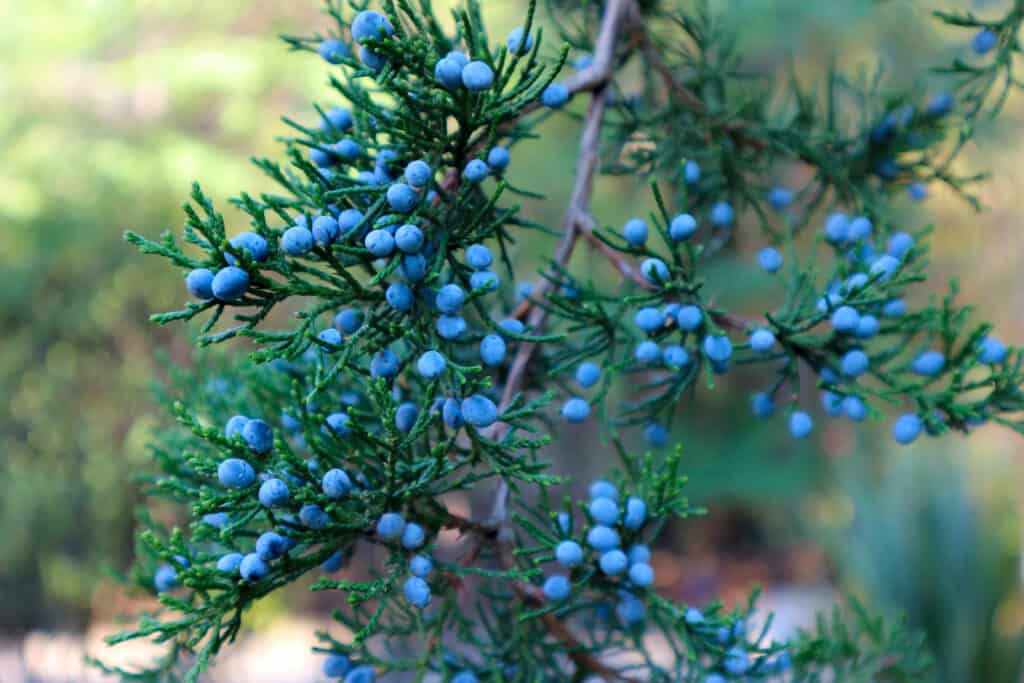
The eastern red cedar is a coniferous evergreen tree.
©iStock.com/Lyudmila Chetvertnykh
7. Gray Birch (Betula populifolia)
The gray birch is a small to medium-sized deciduous tree native to Massachusetts that grows quickly, reaching 20 to 40 feet in height with a 10- to 20-foot spread. It is known for its ability to grow on sandy soils or in early colonized areas on nutrient-deficient and dry sites. This tree usually has multiple trunks branching off from the main trunk. The dark green summer foliage fills out early and is yellow and showy in the fall. Birch seeds are a favorite with many birds, such as finches and other small-seed eaters.
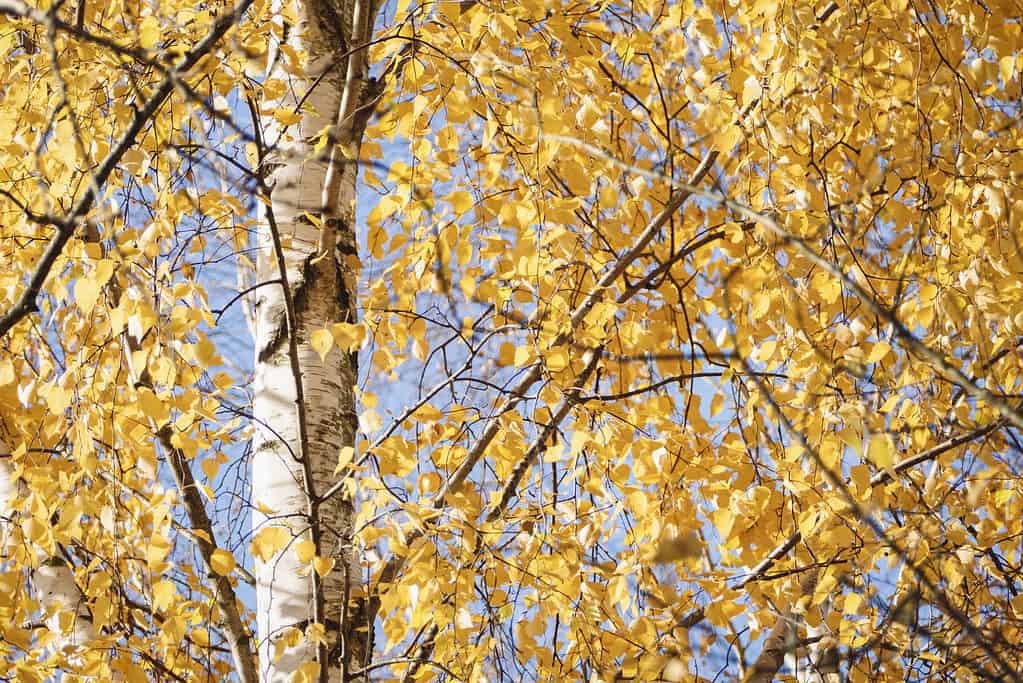
In the fall, the leaves of gray birch trees turn a beautiful yellow color.
©iStock.com/Nadya So
8. Green Ash (Fraxinus pennsylvanica)
Green ash is a tough, fast-growing tree native to Massachusetts that can reach 50 to 75 feet tall. It has a rounded or irregular crown, and its leaves turn yellow in the fall. Green ash prefers moist, rich soils but is adaptable to other conditions. It is tolerant of seasonal flooding but not of shading. You can plant green ash as a shade tree or windbreak and enjoy its beauty for many years to come.
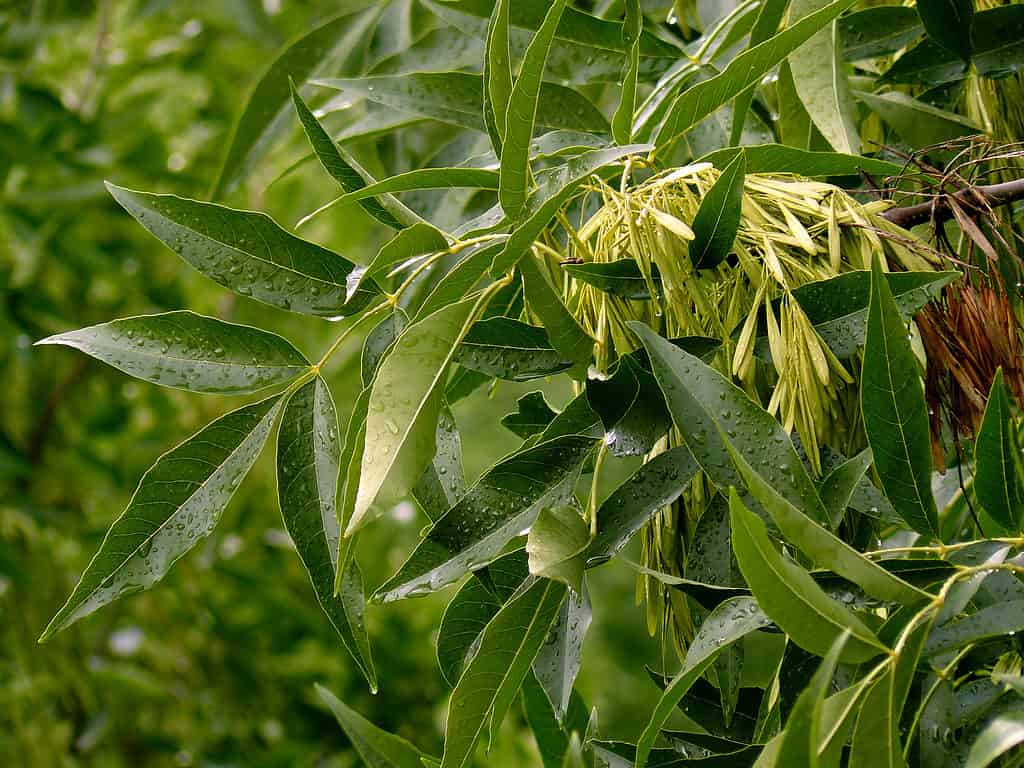
Green ash is also called downy ash, water ash, and swamp ash.
©Denis Pogostin/Shutterstock.com
9. Pitch Pine (Pinus rigida)
The native pitch pine is a variable tree native to Massachusetts that can grow in a variety of conditions, from dry, sandy uplands to swampy lowlands. The tree is known for its ability to survive fires. Pitch pine provides shelter, food, and nesting sites for many animals, and its seeds are eaten by birds such as crossbills, sparrows, woodpeckers, grouse, and quail.
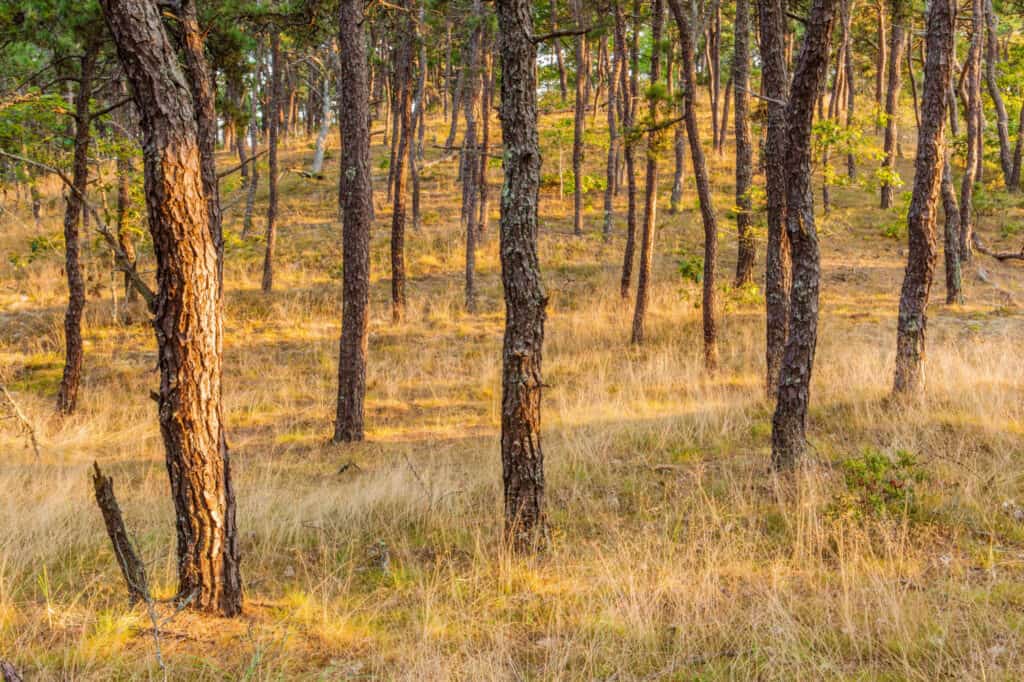
The average pitch pine grows an irregular trunk.
©Danita Delimont/Shutterstock.com
10. Red Maple (Acer rubrum)
Red maple trees are native to Massachusetts and can grow to be quite tall. They change color in the fall before many other trees, with their leaves turning a range of different autumn colors. The flowers of the red maple tree bloom in late March or April and can be either red or orange in color. The tree’s fruit, which are winged seeds known as samaras, are quite small and provide food for squirrels and birds.
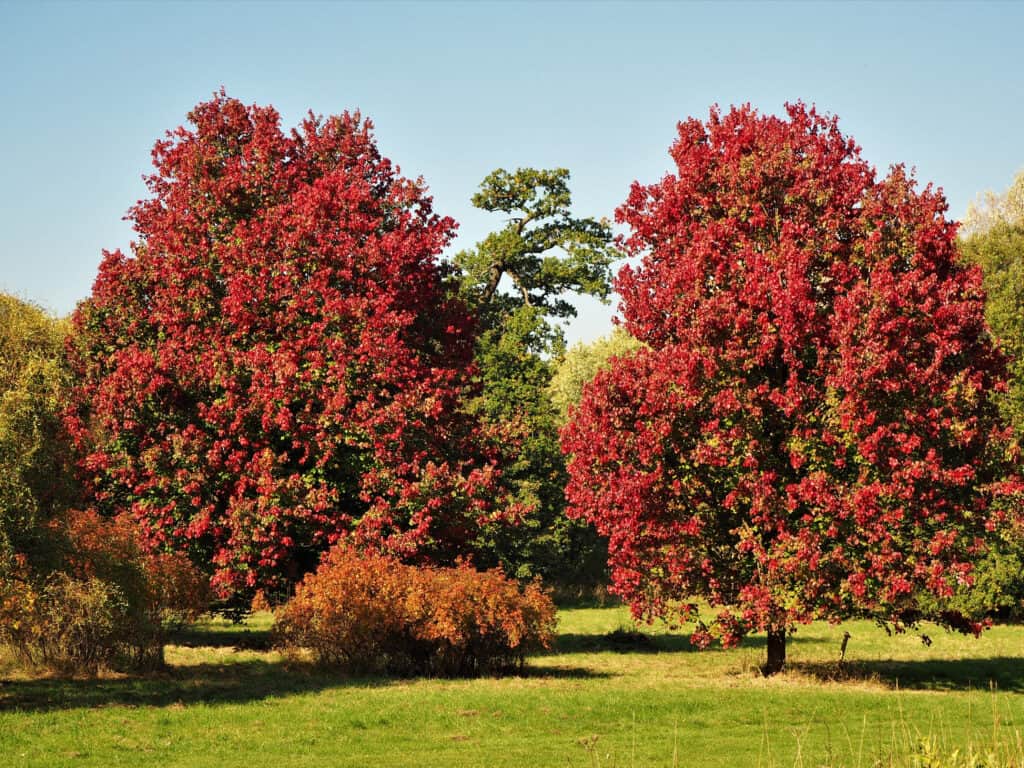
Red maple leaves change color before many other trees, turning a range of different autumn colors.
©AngieC333/Shutterstock.com
11. Sassafras (Sassafras albindum)
Sassafras is a deciduous tree native to Massachusetts that grows between 40 to 50 feet high. It has reddish-brown bark with furrows and ridges. The bright green leaves turn yellow or red-orange in the fall, and the flowers smell so sweet! Many birds, bees, and butterflies are attracted by the sweet flower nectar, and the small, blue fruits are delicious snacks for small mammals.
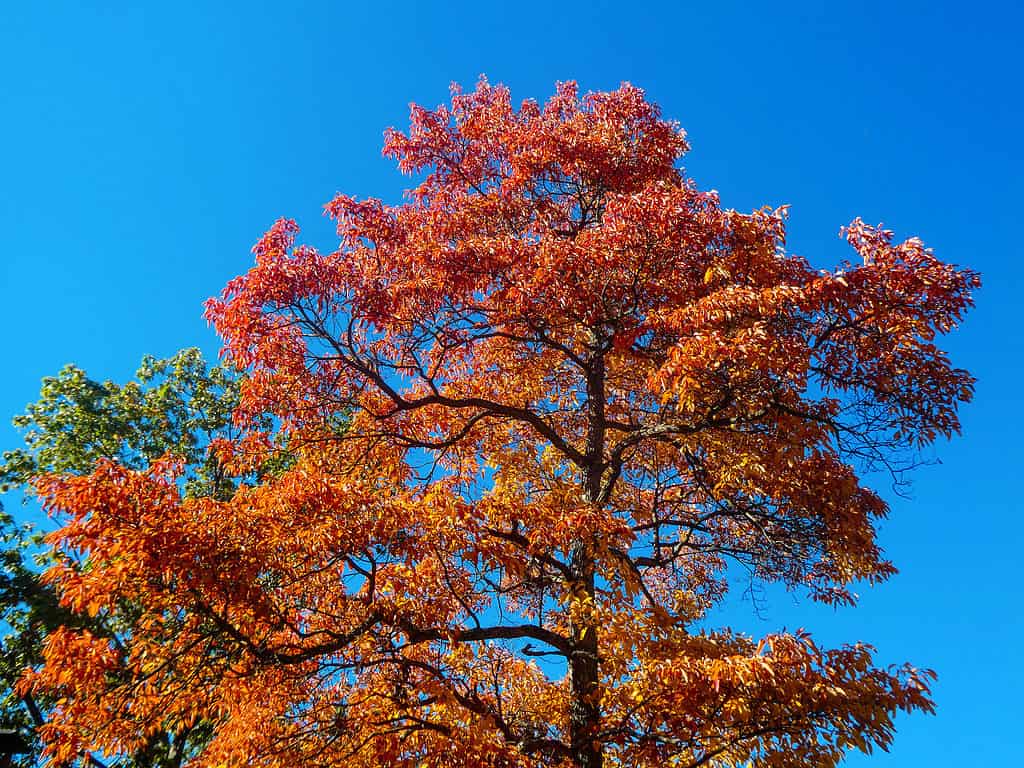
People have found a use for all parts of Sassafras trees
©ForestSeasons/Shutterstock.com
12. White Oak (Quercus alba)
White oak is a large, durable deciduous tree native to Massachusetts that can grow over 100 feet tall and up to 60 to 80 feet wide. It has a wide, round crown with heavy foliage that turns a beautiful red color in the fall. White oak is tough and will tolerate many soil conditions. It is also resistant to salt spray, making it a good choice for areas near the coast. The acorns are a primary source of food for squirrels, chipmunks, raccoons, and other small mammals. White-tailed deer also browse on this tree, as do many birds.
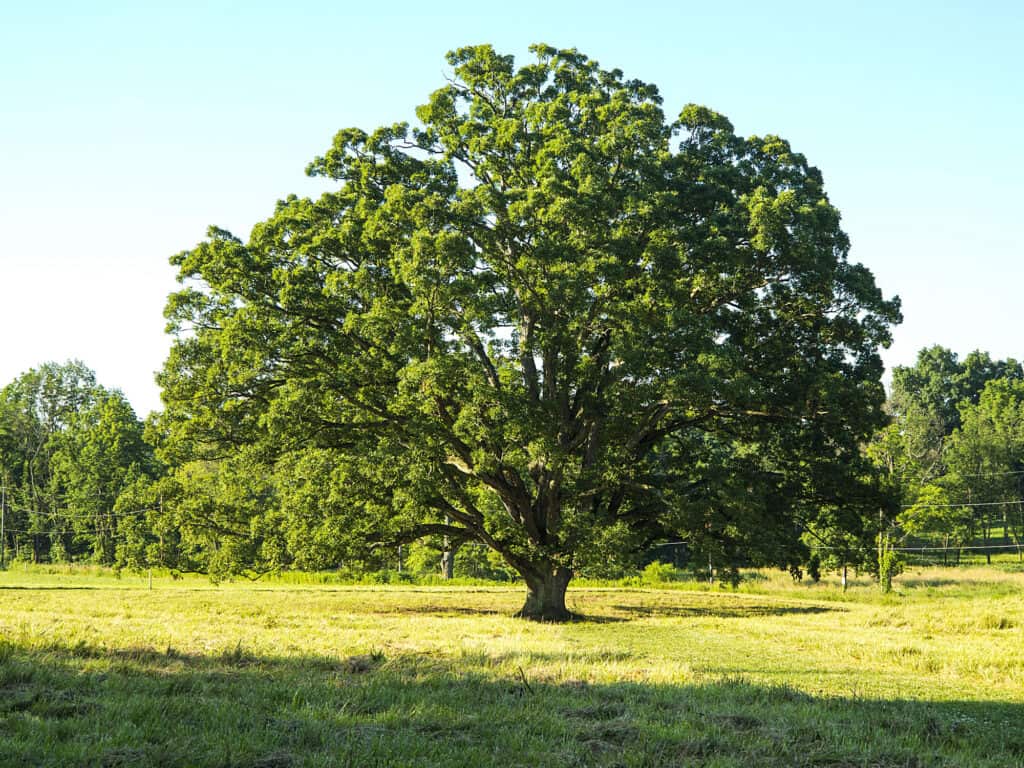
Some white oak trees have been known to live for more than 450 years!
©iStock.com/Cris Andrei
13. State Tree of Massachusetts: American Elm (Ulmus americana)
The American elm was adopted as the state tree of Massachusetts in 1941. General George Washington took command of the Continental Army beneath a large American elm tree in 1775, and the state tree is in remembrance of him.
The American elm is a large tree with flaky gray bark and can grow to be 120 feet tall in the forest. In the open, it is shorter and has a wide spread. The leaves are oval, dark green, and turn to a clear yellow in the autumn.
The American elm tree benefits local wildlife in Massachusetts by providing a source of food and shelter. Its leaves, flowers, and fruits offer sustenance for birds and other animals. The bark is also rich in nutrients that attract squirrels and chipmunks who feed on it year-round. In addition to serving the local wildlife population, this majestic tree also beautifies neighborhoods with its stately presence!
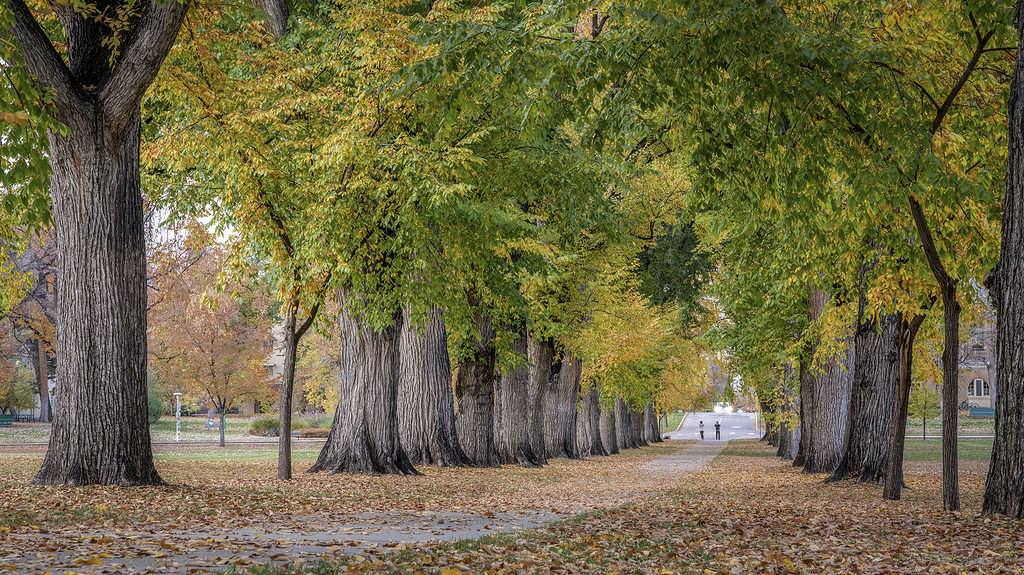
The American elm tree was designated as the state tree of Massachusetts in 1941.
©iStock.com/marekuliasz
Summary of 13 Beautiful Trees Native to Massachusetts
Here’s a recap of the 13 trees native to Massachusetts that we took a look at.
| Rank | Tree | Scientific Name |
|---|---|---|
| 1 | American Holly | Ilex opaca |
| 2 | Atlantic White Cedar | Chamaecyparis thyoides |
| 3 | Black Cherry | Prunus serotina |
| 4 | Black Tupelo | Nyssa sylvatica |
| 5 | Downy Serviceberry | Amelanchier arborea |
| 6 | Eastern Red Cedar | Juniperus virginiana |
| 7 | Gray Birch | Betula populifolia |
| 8 | Green Ash | Fraxinus pennsylvanica |
| 9 | Pitch Pine | Pinus rigida |
| 10 | Red Maple | Acer rubrum |
| 11 | Sassafras | Sassafras albindum |
| 12 | White Oak | Quercus alba |
| 13 | American Elm | Ulmus americana |
The photo featured at the top of this post is © iStock.com/A-Shot-of-Bliss
Sources
- Mass.gov, Available here: https://www.mass.gov/service-details/coastal-landscaping-in-massachusetts-plant-list
- Ipswichma.gov, Available here: https://www.ipswichma.gov/DocumentCenter/View/11229/Native-Trees-of-Massachusetts
- Mashpeema.gov, Available here: https://www.mashpeema.gov/sites/g/files/vyhlif3426/f/uploads/native_plant_list.pdf
- Westford Massachusetts, Available here: https://westfordma.gov/151/Information-on-Common-Wildlife-Species
Thank you for reading! Have some feedback for us? Contact the AZ Animals editorial team.






